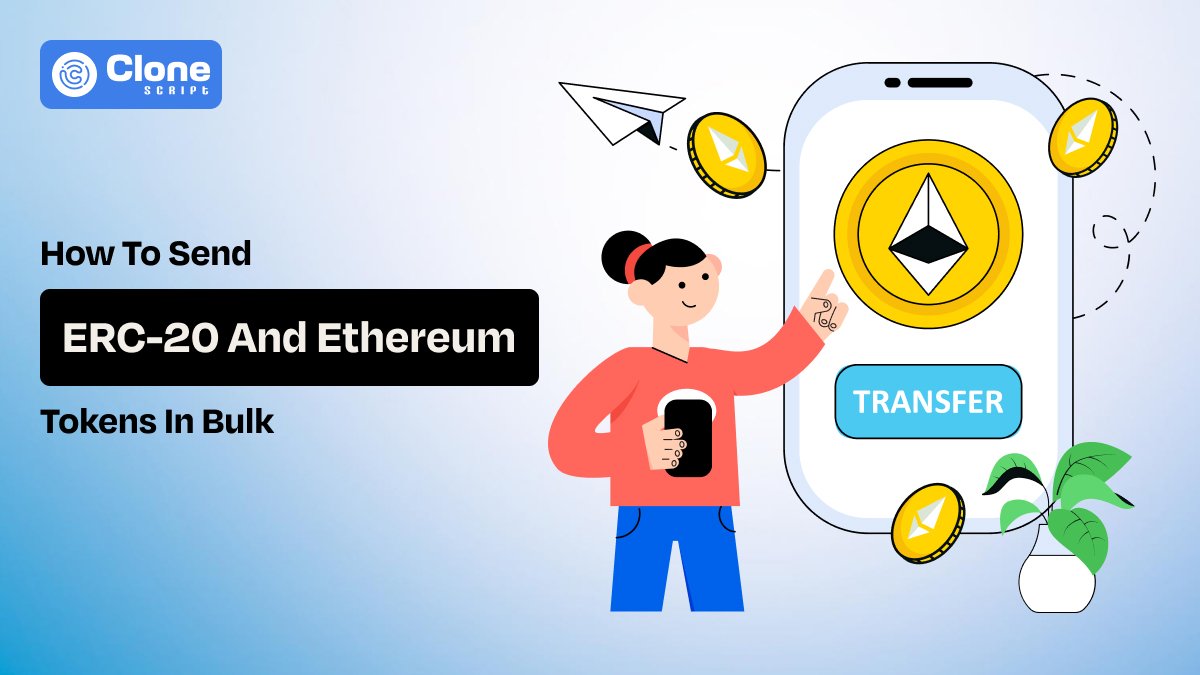How to Send ERC20 and Ethereum Tokens to Multiple Addresses in a Single Transaction
In the blockchain industry, doing things quickly and efficiently is very essential. Many people—whether you’re managing a project, developing software, or running a community face the challenge of sending tokens to many addresses at once. Traditionally, each token transfer required a separate transaction, which can be both time-consuming and expensive.
This is where an efficient token multisender comes in. It’s a smart tool that lets you send ERC20 and Ethereum tokens to multiple addresses in just one go.
In this article, we’ll break down what a multisender is, explain how it works, and highlight the benefits of using it. So anyone can understand and take advantage of this powerful solution for managing token transfers.
What is the Token Multisender?
A token multisender is a smart contract or tool that enables you to execute batch transfers of tokens rather than sending each token individually. In the context of the Ethereum blockchain, this means you can consolidate multiple ERC20 (or Ethereum-based) token transfers to smart contracts into a single transaction. This can quickly reduce the time, cost, and complexity involved.
What Does This Mean for Users?
-
Time Efficiency: Instead of executing hundreds or thousands of individual transactions, you can handle all transfers in one go. This is particularly useful during high-demand periods where blockchain congestion can lead to delays.
-
Cost Savings: Each Ethereum transaction carries a gas fee, and these fees can add up quickly when sending tokens one at a time. By batching your transfers, you reduce the cumulative gas fees.
-
Operational Ease: A single, well-audited smart contract can handle all the transfers, minimizing the risk of human error that might occur with manual processes.
The Challenges of Traditional Bulk Transactions
Before multisenders became popular, sending tokens to multiple addresses required initiating separate transactions for each transfer. This approach was not only inefficient but also prone to errors. Consider the following challenges:
-
High Gas Costs: Every transaction on Ethereum incurs a gas fee. Multiple transactions mean multiplying these fees, sometimes making the process cost-prohibitive.
-
Time Consumption: Each transaction needs to be confirmed on the blockchain, which could take several minutes or even hours during peak times. This is not ideal when you need to distribute tokens quickly.
-
Complex Management: Manually tracking multiple transactions increases the likelihood of mistakes, such as sending tokens to the wrong address or miscalculating amounts.
The multisender solution addresses these issues head-on by combining multiple transfers into a single blockchain transaction.
How Does an Efficient Token Multisender Work?
At its core, an efficient token multisender using smart contract technology to manage batch transactions. Here’s a breakdown of how it functions:
-
Smart Contract Logic: A pre-deployed smart contract is programmed to accept an array of recipient addresses and corresponding token amounts. When you trigger the contract, it processes these arrays and executes transfers in a loop.
-
Batch Processing: Rather than processing each token transfer as a separate transaction, the contract handles them as part of one unified operation. This not only saves on gas fees but also reduces the overall network load.
-
Security Measures: Modern multisender contracts are designed with security in mind. They include mechanisms to prevent common vulnerabilities like reentrancy attacks and ensure that only authorized addresses can initiate transfers.
-
Error Handling: Efficient multisenders are equipped with error-checking functions. If an issue is detected such as an insufficient balance or an invalid recipient address the contract can revert the transaction. This indicates that no tokens are lost or misdirected.
Step-by-Step Guide to Sending Tokens with a Multisender
To give you a clearer picture, here’s a step-by-step guide on how to use an efficient token multicenter:
1. Preparation:
-
Compile Recipient Data: Create a list of recipient addresses along with the token amounts to be sent. Ensure that the data is accurate to avoid any mishaps.
-
Verify Token Balances: Double-check that your wallet has a sufficient token balance and enough ETH to cover the gas fees for the transaction.
2. Setting Up the Multisender:
-
Access the Tool: Many platforms provide a user-friendly interface for multisender functionality. Alternatively, if you’re comfortable with coding, you can deploy a custom smart contract.
-
Input Data: Paste or upload your recipient list into the multisender interface. Some tools also allow you to import data directly from CSV files.
3. Executing the Transaction:
-
Review and Confirm: Before hitting send, review all details to ensure everything is correct. Most platforms will provide a summary of the transaction, including estimated gas fees.
-
Sign and Send: Once confirmed, sign the transaction using your wallet (e.g., MetaMask) and send it to the blockchain. The multisender contract will then process all transfers in one batch.
4. Verification:
-
Monitor the Transaction: Use a blockchain explorer like Etherscan to track the progress of your transaction. Once confirmed, each recipient should see the tokens in their wallet.
-
Audit and Record: Keep a record of the transaction ID and recipient details for future reference and audit purposes.
Advantages of Using a Token Multisender
When it comes to mass token distribution, the benefits of using a multisender are:
1. Cost-Effectiveness
Batch processing significantly reduces gas fees compared to executing numerous individual transactions. This can be a game-changer, especially during periods of high network congestion where gas prices reach to high level.
2. Enhanced Efficiency
By reducing the number of transactions, you not only save time but also simplify the management process. This streamlined approach makes it easier to coordinate large-scale token distributions, such as airdrops or rewards programs.
3. Improved Security
Utilizing a well-audited multisender smart contract minimizes the risks associated with manual transactions. Built-in security features protect against vulnerabilities, and your tokens are transferred safely and securely.
4. Scalability
As blockchain projects grow, the need to distribute tokens efficiently becomes a key aspect. Multisenders provide a scalable solution that can handle increasing numbers of transactions without a corresponding increase in complexity.
Practical Use Cases for Token Multisenders
The applications for token multisenders extend far beyond mere convenience. Here are some scenarios where they can be particularly beneficial:
1. Airdrops and Token Distributions
Airdrops are a popular method to distribute tokens to a large audience, often as a meme coin marketing strategy or a reward for community participation. A multisender allows projects to distribute tokens quickly and efficiently. So, all participants receive their share simultaneously.
2. Staking and Yield Rewards
For platforms that offer staking or yield farming, distributing rewards regularly is essential. A multisender can automate this process, reducing administrative overhead and checks that rewards are delivered on time.
3. Payroll and Incentives
Some blockchain-based companies use cryptocurrencies to pay employees or distribute bonuses. A multisender can handle payroll in a single transaction, making the process more efficient and transparent.
4. ICO and Token Sale Allocations
During an Initial Coin Offering (ICO) or token sale, managing investor contributions and token allocations can be complex. Multisenders simplify this process by allowing the project team to distribute tokens to multiple investors in one go.
Best Practices for Safe and Secure Token Multisending
While the benefits of a token multisender are significant, it’s important to follow best practices to know security and reliability:
1. Use Audited Smart Contracts
Before deploying or using any multisender solution, verify that the underlying smart contract has been thoroughly audited by reputable security firms. This step is crucial in preventing exploits and vulnerabilities.
2. Test on a Testnet
Always test your multisender on a testnet (e.g., Ropsten or Rinkeby) before executing a transaction on the Ethereum mainnet. Testing helps identify any potential issues without risking ERC-20 real tokens.
3. Maintain Accurate Data
Errors in recipient addresses or token amounts can lead to irreversible mistakes. Use reliable data sources and double-check your recipient lists before initiating a transaction.
4. Monitor Gas Prices
Gas fees on Ethereum can fluctuate quickly. Monitor the network conditions and choose an optimal time for executing large transactions to minimize costs.
5. Keep Transaction Records
Maintaining detailed records of each multisend transaction including transaction IDs, recipient addresses, and amounts can be invaluable for future audits and troubleshooting.
The Future of Multisending in Blockchain Technology
As blockchain technology continues to change, the need for efficient transaction management will only increase. The development of multisender tools reflects a broader trend toward automation and scalability in the crypto field.
1. Layer 2 Solutions and Scalability
With the emergence of layer 2 solutions like Optimism and Arbitrum, the scalability of the Ethereum network is set to improve beyond expectations. These advancements will further reduce gas fees and make multisending even more cost-effective, paving the way for wider adoption in various sectors.
2. Increased Adoption Across Industries
From finance to gaming, the applications of blockchain technology are expanding. Multisender solutions are likely to become a staple for any project that involves mass token distributions. Businesses can operate more efficiently and securely in a decentralized environment.
3. Interoperability and Cross-Chain Capabilities
As interoperability between different blockchain networks improves, we can expect multisender tools to support multiple token standards (such as ERC20, BEP20, and beyond). This would allow for even broader applications and more seamless integration across various platforms.
Conclusion
Using an efficient token multisender simplifies bulk transfers of ERC20 and Ethereum tokens, saving time and reducing costs while enhancing security. Use this tool to streamline your operations and achieve smoother, safer token distributions across your blockchain projects.
Contact us for a complete setup of your bulk Ethereum token sending.
 BTC - Bitcoin
BTC - Bitcoin
 USDTERC20 - USDT ERC20
USDTERC20 - USDT ERC20
 ETH - Ethereum
ETH - Ethereum
 BNB - Binance
BNB - Binance
 BCH - Bitcoin Cash
BCH - Bitcoin Cash
 DOGE - Dogecoin
DOGE - Dogecoin
 TRX - TRON
TRX - TRON
 USDTTRC20 - USD TRC20
USDTTRC20 - USD TRC20
 LTC - LiteCoin
LTC - LiteCoin







